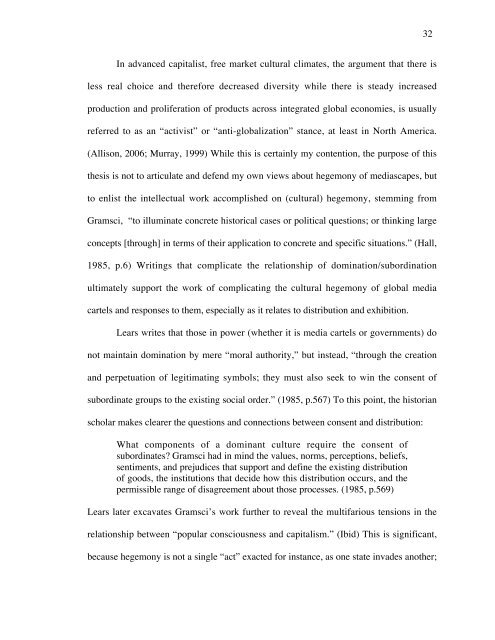The Spaces Between Grassroots Documentary ... - Ezra Winton
The Spaces Between Grassroots Documentary ... - Ezra Winton
The Spaces Between Grassroots Documentary ... - Ezra Winton
You also want an ePaper? Increase the reach of your titles
YUMPU automatically turns print PDFs into web optimized ePapers that Google loves.
In advanced capitalist, free market cultural climates, the argument that there is<br />
less real choice and therefore decreased diversity while there is steady increased<br />
production and proliferation of products across integrated global economies, is usually<br />
referred to as an “activist” or “anti-globalization” stance, at least in North America.<br />
(Allison, 2006; Murray, 1999) While this is certainly my contention, the purpose of this<br />
thesis is not to articulate and defend my own views about hegemony of mediascapes, but<br />
to enlist the intellectual work accomplished on (cultural) hegemony, stemming from<br />
Gramsci, “to illuminate concrete historical cases or political questions; or thinking large<br />
concepts [through] in terms of their application to concrete and specific situations.” (Hall,<br />
1985, p.6) Writings that complicate the relationship of domination/subordination<br />
ultimately support the work of complicating the cultural hegemony of global media<br />
cartels and responses to them, especially as it relates to distribution and exhibition.<br />
Lears writes that those in power (whether it is media cartels or governments) do<br />
not maintain domination by mere “moral authority,” but instead, “through the creation<br />
and perpetuation of legitimating symbols; they must also seek to win the consent of<br />
subordinate groups to the existing social order.” (1985, p.567) To this point, the historian<br />
scholar makes clearer the questions and connections between consent and distribution:<br />
What components of a dominant culture require the consent of<br />
subordinates? Gramsci had in mind the values, norms, perceptions, beliefs,<br />
sentiments, and prejudices that support and define the existing distribution<br />
of goods, the institutions that decide how this distribution occurs, and the<br />
permissible range of disagreement about those processes. (1985, p.569)<br />
Lears later excavates Gramsci’s work further to reveal the multifarious tensions in the<br />
relationship between “popular consciousness and capitalism.” (Ibid) This is significant,<br />
because hegemony is not a single “act” exacted for instance, as one state invades another;<br />
32


